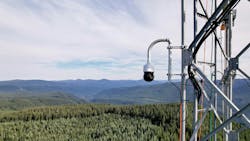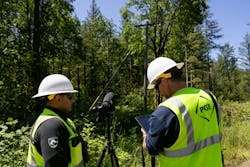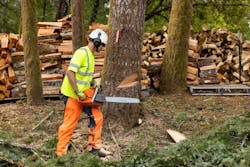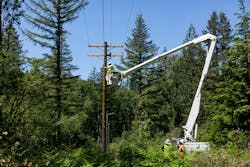Wildfires are a growing national issue, affecting more communities across the U.S. each year. With increased frequency, intensity and unpredictability, wildfires cause environmental devastation, health impacts, community displacement and economic loss. In 2024 in Oregon, more than 2000 fires burned almost 2 million acres (809,371 hectares) — a 302% increase above the state’s 10-year average.
“Our focus remains on protecting communities through investments in infrastructure hardening, advanced technology for situational awareness, community engagement and year-round collaboration with agencies and emergency responders,” said Kellie Cloud, senior director of wildfire and operational compliance for Portland General Electric (PGE). “By using cutting-edge technology and building strong community partnerships, we are working to prevent wildfires while fostering a more resilient energy future for Oregon.”
Launched in 2018, PGE’s wildfire prevention strategies are reducing wildfire risk in designated high fire risk zones (HFRZs). Over the last few years, key initiatives by the utility include enhancing vegetation management, developing a fire risk assessment model, targeting system hardening investments, establishing a wildfire operations team and implementing public safety power shutoffs.
“In less than 10 years, we have significantly advanced our understanding of the wildfire risk in our service area,” Cloud noted. “We work day in and day out to counter and prevent wildfire threats.”
Understanding Risk
PGE is at the forefront of wildfire risk management, executing a comprehensive approach to understanding and preventing fire hazards in its service area. At the heart of this strategy is an annual wildfire risk mitigation assessment, which is a thorough evaluation that incorporates the latest in system design changes, advanced modeling techniques and scientific analysis. This assessment helps to identify and update HFRZs and considers a range of factors, including asset locations, environmental changes, weather impacts and potential fire behavior.
Wildfire prevention measures require substantial investments over time, which is why utilities must be vigilant about how they use customer dollars. In support of these efforts, PGE became the first utility in Oregon to develop a cost-benefit approach to its vegetation management program, enabling it to balance the cost of prevention measures with customer price impacts. Typically used for large capital investments, this cost-benefit approach integrates weather, environmental factors and fire behavior models to inform the utility’s vegetation management efforts in HFRZs.
A Resilient Grid
“One of the key aspects to building a resilient grid is our capital investments,” said Brett Phillips, senior manager of wildfire operations program management for PGE. “These are actions and programs to strengthen the grid such as overhead-to-underground conversion projects, replacing wood poles with ductile iron poles and installing technologies like sensors and artificial intelligence (AI) cameras that provide situational awareness.”
Investments like the ones Phillips refers to are some of the capital investments PGE is planning for over the next three years to four years that will be in service for more than 50 years.
PGE has deployed an array of advanced technologies across its service area, including a network of 37 high-definition AI cameras strategically positioned across HFRZs and near critical generation facilities. These cutting-edge cameras provide real-time visual data to both PGE and over 190 fire agencies, greatly improving response times and coordination efforts.
Complementing this advanced-tech camera network are 85 PGE-installed weather stations, with plans to add more in 2025. These stations provide PGE’s meteorological team with precise weather condition information, a crucial factor in predicting and managing wildfire risks.
“Another important aspect to building a resilient grid is our operational programs,” said Philips. “We project these initiatives, like vegetation management and enhanced inspections, will continue to reduce risk in our high fire risk zones.”
At the forefront of this effort is PGE's advanced wildfire risk reduction (AWRR) program, a year-round enhanced vegetation management effort, which has already demonstrated remarkable success, particularly in heavily forested areas on Mount Hood, where the program achieved an almost 75% reduction in ignition risk events and outages during fire seasons, which in Oregon runs approximately from June to November.
Phillips said the AWRR program, which focuses on strategic vegetation management and patrols during active growth periods, is predicted to prevent 174 ignitions annually. Complementing this, the utility’s rigorous annual ignition prevention inspections in HFRZs aim to identify and correct potential fire hazards, with projections indicating these efforts could prevent an additional seven ignitions each year.
Engaging the Community
Throughout the year, PGE works closely with local, state and federal land and emergency management agencies like the U.S. Forest Service, Bureau of Indian Affairs and Land Management, Oregon Department of Forestry, and local tribes, fire districts and emergency responders. PGE conducts outreach and community engagement year-round in support of wildfire planning and mitigation across its service area, which helps to prepare the utility and community for a wide range of emergencies and events such as active wildfire response and public safety power shutoffs.
“Collaborating with and maintaining strong relationships with these organizations helps PGE coordinate and plan for potential emergencies,” said Brooke Brownlee, PGE’s senior manager of community engagement. “Planning early and often also establishes clear lines of communication and close coordination before, during and after events.”
A National Solution
The teams at PGE work tirelessly to build a resilient grid that can stand up to the impact and threat of wildfire while bolstering system-wide reliability. However, PGE is just one part of the solution to the issue of wildfire. It will take everyone: state and federal agencies, utilities, companies and customers working together to help prevent wildfires and promote community preparedness.
About the Author
Ben Felton
Ben Felton is the executive vice president and chief operating officer of PGE. With more than 30 years of energy industry experience, Felton held positions with Consumers Energy, NiSource Inc. and DTE Energy prior to joining PGE. He most recently served as the senior vice president of energy supply at DTE. He held a variety of senior leadership positions, including leading electric operations and power delivery at NIPSCO, a subsidiary of NiSource, and the electric systems operations and maintenance at Consumers Energy.



